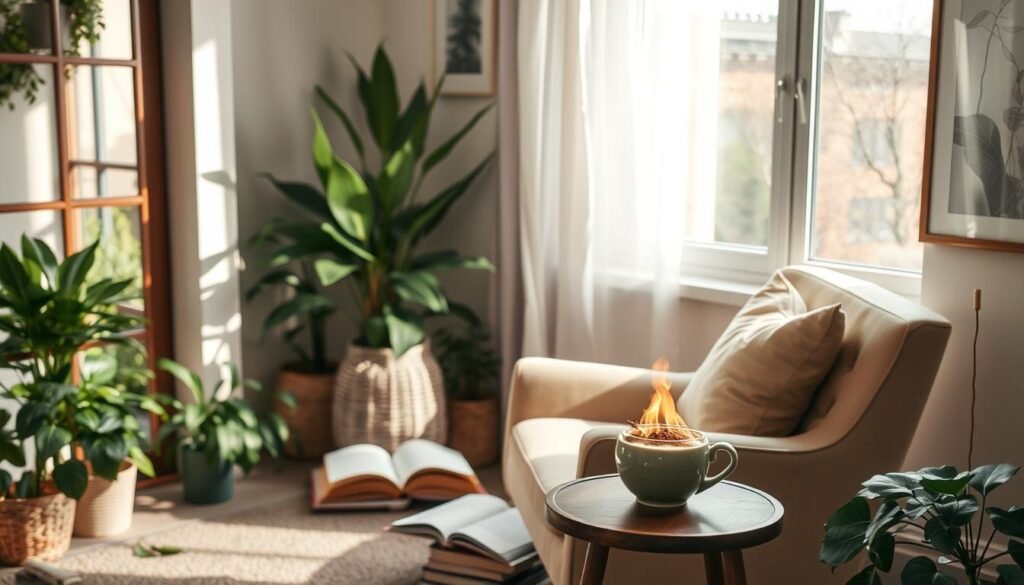Did you know about 73% of people feel tense in their jaw, neck, and shoulders without knowing? This fact shows how common anxiety is in our lives. It’s important to learn how to fight anxiety for our mental and physical health. This article shares useful ways to manage anxiety every day. By using these tips, you can find peace and improve your life.
Taking short breaks and being active can help clear your mind. It’s key to know the signs and what causes your anxiety. This way, you can build a set of tools to deal with it. Mindfulness, eating right, and getting support are great ways to handle anxiety naturally.
If you want more tips and deep advice, check out this resource on easing anxiety.
Key Takeaways
- Learning techniques such as diaphragmatic breathing activates calmness through the parasympathetic nervous system.
- Creating a supportive environment with friends and family significantly reduces anxiety levels.
- Engaging in regular physical activity is vital for releasing mood-boosting serotonin.
- Utilizing relaxation methods like yoga and meditation can promote a sense of inner peace.
- Consuming foods like honey and green tea can contribute to lowering stress responses.
Understanding Anxiety and Its Effects
Anxiety is a complex feeling that many people deal with every day. It’s important to know about its mental and physical signs. About 19.1% of U.S. adults face anxiety disorders yearly. This includes problems like generalized anxiety, social anxiety, and panic disorder, affecting millions.
The impact of anxiety effects on personal life and society is huge. Anxiety makes simple daily tasks hard, lowers productivity, and harms well-being. The cost is big too, with losses over $42 billion a year in work and medical bills.
There are many symptoms of anxiety, such as worry and feeling restless, and also physical symptoms like a fast heartbeat. Most mental health issues start by age 14, so it’s key to help early. Anxiety often comes with other problems like depression, making it crucial to find the right treatment.
Understanding the many signs of anxiety helps in tackling it. Knowing the impact of anxiety on individuals and communities leads to better solutions and care. The challenge of understanding anxiety grows as more people seek support.
| Aspect | Statistics |
|---|---|
| Anxiety Disorders Prevalence | 19.1% of adults |
| Generalized Anxiety Disorder | About 7 million adults |
| Panic Disorder | Approximately 6 million adults |
| Anxiety’s Onset | 75% show symptoms before age 21 |
| Comorbidity Rate with Depression | 50% diagnosed also have a mood disorder |
Identifying Triggers for Anxiety
It’s vital to know your anxiety triggers to manage symptoms well. Anxiety varies, from slight nervousness to intense panic attacks disrupting life. Causes of anxiety range from major life changes, health conditions, to certain meds. Understanding these triggers helps in tackling anxiety effectively.
Keeping a journal helps in tracking feelings and experiences. It lets you see patterns that emerge over time. This method assists in spotting anxiety triggers like drinking caffeine, avoiding certain situations, and attending social events. Making regular notes can identify the exact causes of anxiety. This empowers you to create personalized coping strategies.
- Common anxiety triggers include:
- Health issues, such as thyroid problems or low blood sugar
- Social conflicts, like disagreements with friends or family
- Financial concerns related to bills or retirement planning
- Daily routines disrupted by major life changes or new jobs
Knowing these triggers improves the outcome of therapy. Cognitive behavioral therapy (CBT) offers tools for dealing with anxiety causes, including past trauma. Studies confirm the effectiveness of addressing these underlying issues.
For more info on spotting and managing anxiety triggers, visit this resource.
How to Ease Anxiety: The Importance of Facing Fear
Facing fear is key in easing anxiety. It sounds scary, but facing fears can boost emotional well-being. Trying small acts of bravery, like talking in front of a few people, helps you get used to your fears. This can lead to feeling better for a long time.
Taking Small Acts of Bravery
Small brave steps can greatly help those fighting anxiety. Studies show about 75% feel less anxious after confronting their fears. By breaking big fears into smaller parts, you face them bit by bit. This consistently lowers anxiety levels. Over time, you learn to handle your fears with more confidence.
Long-Term vs Short-Term Relief
Knowing the difference between quick relief and lasting solutions is crucial in managing anxiety. Techniques like deep breathing offer instant ease but don’t solve the underlying issue. Meanwhile, long-term methods such as cognitive-behavioral therapy and facing your fears can greatly cut down anxiety. These approaches aim for a real, lasting recovery.
| Type of Relief | Description | Effectiveness |
|---|---|---|
| Short-Term Relief | Immediate techniques such as deep breathing or distraction. | Temporary reduction in anxiety |
| Long-Term Relief | Strategies like exposure therapy and CBT. | 50-90% reduction in anxiety symptoms |
Anxiety Relief Techniques: Breathing Exercises
Breathing exercises are great for relieving anxiety. They are a simple way to manage stress and anxiety by controlling your breath. Using diaphragmatic breathing is especially powerful. It uses deep breaths from the diaphragm to bring relaxation and fight the “fight-or-flight” response.
Diaphragmatic Breathing Explained
To start diaphragmatic breathing, here’s what you do:
- Find a comfortable position, either sitting or lying down.
- Place one hand on the chest and the other on the abdomen.
- Inhale deeply through the nose, making sure your abdomen expands, not your chest.
- Exhale slowly through pursed lips, letting your abdomen fall gently.
Studies in Frontiers in Psychology show diaphragmatic breathing lowers stress’s negative effects. Doing it daily can reduce anxiety.
How Breathing Affects the Nervous System
Controlled breathing significantly impacts our nervous system. It triggers the parasympathetic nervous system, calming us down. Research ties slower breathing to reduced heart rate. This helps conserve energy during stress.
Resonance breathing, for example, improves heart rate variability. This may boost your mood. Methods like the 4-7-8 technique or lion’s breath are proven to help with anxiety. Consistent practice can ease anxiety attacks and manage chronic anxiety. Lower anxiety levels indicate these practices are effective for better well-being. For more on these breathing exercises for anxiety, guided sessions are advisable. Click here to learn more.

Relaxation Techniques for Anxiety: Finding Your Calm
Many people today search for effective relaxation techniques for anxiety to feel better and find peace. These methods are key in handling anxiety and improving emotional health. Among the best are yoga, meditation, and using music, each with its own way to help find calm in anxiety.
Yoga and Meditation
Yoga and meditation are whole-body approaches to relaxation. They help you pay attention to your breath and body, bringing mindfulness. Some studies show regular mindfulness practice can cut anxiety by 30%. Yoga helps you notice how your body feels and creates a peaceful setting.
Doing slow, deep breaths during meditation can also decrease anxiety over time. Making yoga or meditation a regular part of life builds strength to face anxiety triggers.
Using Music as a Relaxation Tool
Music is widely used to help manage anxiety. Certain songs, like “Weightless” by Marconi Union, can lower anxiety by up to 65%. Calming tunes shift focus from stress and lift your mood, proving very effective in finding peace. Adding music therapy to your daily life greatly benefits your emotional health. For more on music’s healing power, check out this resource.
| Technique | Benefit | Effectiveness |
|---|---|---|
| Yoga | Enhances mindfulness and physical relaxation | 30% reduction in anxiety |
| Meditation | Promotes deep relaxation and emotional awareness | 30% reduction in anxiety |
| Music Therapy | Induces relaxation and distracts from stressors | 65% reduction in anxiety |
| Deep Breathing | Reduces tension and improves oxygen flow | 40% reduction in anxiety |
Mindfulness for Anxiety: Staying Present
Mindfulness helps us handle big feelings by keeping us in the now. It cuts down on negative thinking that makes anxiety worse. Using mindfulness, we can better understand and control our thoughts.
The Mindfulness-Based Stress Reduction (MBSR) course is an 8-week program that lowers stress. Studies show it really helps with anxiety and panic, especially for those with general anxiety disorder. Mindfulness-Based Cognitive Therapy (MBCT) can cut the chance of depression coming back by half.
You don’t need a lot of time to practice mindfulness. Just 10 minutes of meditation a day can make you more focused. Even simple activities like breathing exercises or feeling your feet on the ground can keep you anchored in the present. Here are a few easy ways to start:
- Mindful Breathing: Concentrate on your breathing to stay in the moment.
- Body Scan: Pay attention to how each part of your body feels, without judging.
- Nature Walks: Take in everything around you with all your senses on a walk.
- Guided Meditations: Use apps or websites for guided practices focused on the present.
Mindfulness gets stronger with regular practice. Making it a daily habit can significantly help with anxiety and mood problems. Considering 4% of adults worldwide face chronic anxiety, mindfulness could be a key to feeling more stable emotionally.
| Mindfulness Technique | Benefits | Implementation Time |
|---|---|---|
| Mindful Breathing | Increases relaxation and focus | 5-10 minutes |
| Body Scan | Enhances body awareness and reduces tension | 10-15 minutes |
| Nature Walks | Improves mood and provides mental clarity | 20-30 minutes |
| Guided Meditations | Supports sustained mindfulness practice | 10-30 minutes |

Coping with Anxiety Naturally: Nutrition and Lifestyle
Nutrition and lifestyle choices greatly affect anxiety levels. Following healthy habits helps people manage anxiety in a natural way. A balanced diet and regular exercise are key. They boost overall health and mood, bringing a feeling of well-being.
The Role of Balanced Meals
Eating right keeps your energy steady all day. Starting the day with protein helps control blood sugar. This can stop energy dips that may make anxiety worse. Choosing foods like whole grains can also help. They make you feel calm by boosting serotonin.
Staying hydrated is crucial for your mood. Not drinking enough water can make you anxious. It’s also wise to watch how much alcohol and caffeine you have. Alcohol might seem relaxing at first, but it can disturb your sleep. Less caffeine can help you feel less jittery.
Exercise for Mental Health
Being active is good for lowering anxiety. Exercise releases endorphins, making you feel happier. People who exercise regularly are much less likely to feel anxious. Working out helps you sleep better and reduces stress. Together with healthy eating, it makes a great anxiety-fighting routine.
For more tips on using diet and exercise to fight anxiety, visit this resource.
Self-Care for Anxiety: Prioritizing You
Self-care is key in handling anxiety well. It helps people put their well-being first every day. With 40 million U.S. adults affected by anxiety, self-care routines are crucial.
One strategy is to make time for relaxing activities. Hobbies like painting or gardening help focus away from worry. Being kind to oneself, like you would to a friend, is also important.
Setting boundaries is critical for mental health. Saying no keeps your time and mind safe. Socializing and joining community events fight loneliness and build connection.
Eating well and staying active play big roles in mental health care. Foods like fruits and veggies help lessen anxiety feelings. Exercising for 150 minutes a week can cut anxiety by 40%.

| Self-Care Strategies | Benefits |
|---|---|
| Setting Personal Boundaries | Protects mental energy and reduces anxiety triggers |
| Engaging in Hobbies | Diversion from anxious thoughts; enhances joy |
| Regular Exercise | Reduces anxiety symptoms; boosts overall mood |
| Mindfulness Practices | Lowers anxiety symptoms significantly |
| Healthy Nutrition | Improves physical health and anxiety management |
Self-care builds strength in dealing with mental health. Taking time for rest and joy reduces anxiety. By caring for themselves, people improve their mental health and overall happiness.
Anxiety Management Strategies: Talking About Your Feelings
Anxiety impacts millions in the U.S. each year, with around 40 million adults affected. Talking about feelings helps manage this anxiety. It leads to better mental health.
When people share their feelings, they find emotional relief. This helps them understand what triggers their anxiety.
Using Words to Describe Emotions
Explaining your feelings helps make them clear. People who talk about their feelings often feel less anxious. They feel a sense of belonging by sharing experiences.
This method is key for handling anxiety. It helps unravel complex feelings. Around 85% of individuals feel calmer after talking about their emotions.
Engaging the Analytical Part of the Brain
Talking about emotions triggers the brain’s logical side. This helps people process and understand their anxiety. It leads to awareness and can ease anxiety’s physical effects.
| Benefits of Talking About Feelings | Impact on Anxiety Levels |
|---|---|
| Enhanced Emotional Clarity | Improved Coping Mechanisms |
| Increased Support | Reduction in Physical Symptoms |
| Greater Self-Awareness | Lowers Anxiety Levels by up to 50% |
| Promotion of Mindfulness | Improved Emotional Resilience |
Using these strategies helps heal and improve well-being. Starting the conversation about your feelings is a big step. It leads to better understanding and control of anxiety.
Conclusion
Understanding how to ease anxiety is vital for our well-being and the health of our society. Around 40 million adults in the U.S. suffer from anxiety disorders. This shows the need to identify symptoms and find good ways to relieve anxiety.
It’s important to recognize what causes our anxiety. We can then use mindfulness and relaxation to help ourselves. Everyone is encouraged to find what works best for them.
Actionable strategies like psychotherapy and exercise are very helpful. They work well with natural methods like eating a balanced diet. This approach helps fight anxiety by tackling both mind and body issues. It also makes our overall life better.
It’s crucial to overcome the stigma around mental health. This lets more people get the help they need. Perfect mental health is a key part of a happy life.
The journey to relieving anxiety requires commitment to personal growth. Embracing a well-rounded approach is essential. With the tips from this article, people can face their mental health challenges with hope. This builds a caring community that supports understanding and resilience.